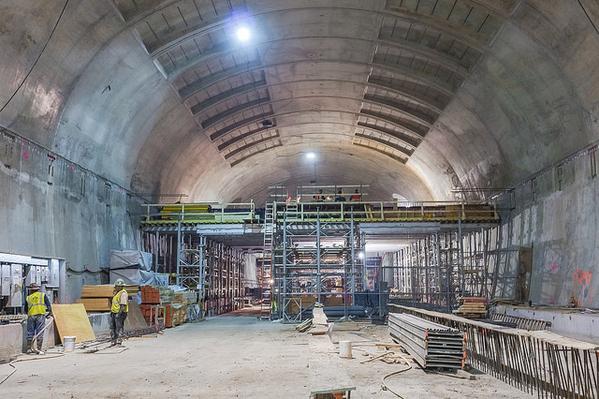
Construction of the 2nd Avenue Subway (photo: Philip Plotch)
The proposed Select Bus Service (SBS) on Woodhaven and Cross Bay Boulevard scheduled for completion in 2018 is not like any other that we have seen in these parts. According to the New York City Department of Transportation (DOT), it is "bigger and bolder." It is also much more expensive. While other SBS routes have cost between $10 million and $20 million for installation, the proposed SBS route in Queens would cost a minimum of $231 million and could cost many millions more after all the necessary engineering studies are completed.
Why so expensive? We don't know. Neither the MTA nor DOT has explained why the original projected cost of $20 million suddenly rose tenfold after community meetings and workshops were held when switching from SBS to Bus Rapid Transit (BRT). The distinctions are numerous, but DOT has muddied the waters by using both terms interchangeably.
DOT currently is short of the funding necessary for project completion. The intention as stated before a City Council hearing last fall is to spend as much federal funding as could be obtained, perhaps beginning the project as BRT and completing it as SBS. That is where the Second Avenue Subway comes in. The two projects are in competition for the same federal funds under the "New Starts" program.
During the 1970s when costs started to escalate, the MTA proposed splitting the Second Avenue project into two phases postponing work that had already been started on the Lower East Side. The powerful (and now recently disgraced) Assembly Member Sheldon Silver protested, resulting in postponement of the entire project for decades. When work was finally resumed, costs had increased so much that the project had to be split into four phases with numerous delays to Phase 1, now scheduled for completion next year. Phase 2 funding would extend the project from 96th to 125th Street and is uncertain with a $15 billion shortfall in the MTA capital program and the governor missing in action.
Therefore, if the SBS route is constructed in Queens as currently envisioned, the next phase of the Second Avenue Subway could be delayed, but that is not all. Most likely this SBS route would mean the nearby parallel abandoned Rockaway Beach Line would never be reactivated as the same powerful groups who seek to turn it into parkland support SBS on Woodhaven. What's more, this obvious alternative was not included in the study of the SBS line, which was a forgone conclusion before the first community meeting was held where it was merely presented as "one alternative."
Numerous questions have been asked by community members, which have not been answered. Not only is the initial cost prohibitive, but each SBS route, of which there are now seven, costs between $2 and $4 million a year more to operate than existing local and limited services.
This is mainly due to the enforcement required to ensure fares are being paid and for maintenance of new offboard equipment these routes require. Yet ridership on these routes mostly continue to decline as does bus ridership on the rest of the bus system with the exception of routes in the Bronx. Paid ridership on the B44 SBS in Brooklyn declined by 4.4 percent during the past year, a metric possibly explained by increased fare evasion.
The problems and disadvantages with these SBS routes are too numerous to fully mention here. However, if you attend any of the DOT presentations you would think that SBS is a panacea with no disadvantages. But rather than first recognizing and attempting to solve these problems, the city is moving full steam ahead to create 13 new SBS routes before the end of Mayor de Blasio's term.
The basic premise is "trust us." Neither traffic nor transit modeling data which supposedly justify the need for these routes has been released while safety problems in the Woodhaven corridor have been greatly exaggerated.
SBS buses operate no more reliably than existing routes and still often bunch two or three buses at a time. Exclusive bus lanes at all times and prohibition of an additional 23 left turning movements and elimination of left turn lanes on Woodhaven and Cross Bay will tie existing traffic into knots, while minimally improving bus service for some and making it more inconvenient for others by the removal of some bus stops.
All SBS routes with the exception of one have had an initial first year assessment. That is because ridership initially increased on those routes, sometimes by as much as ten percent. The MTA is using that statistic to justify new routes and is ignoring the more recent SBS bus ridership decline. Ignoring it so much that they still have not and may never release a first year assessment for the B44 SBS due to the fear of jeopardizing future SBS routes. After all, how would they explain a 4.4 percent reduction in bus ridership, which is more than twice the borough average decline, when SBS is supposed to be the city's panacea for improving mass transit?
***
Allan Rosen is a former director of Bus Planning for MTA New York City Transit and is now retired and blogs for SheepsheadBites.com




